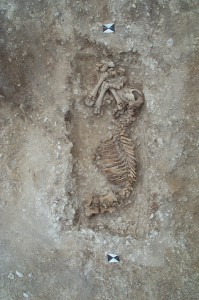The Cartesian Dualists of the press, if not those of the hallowed groves of academe, are at it again. Der Spiegel, late last month, and The Independent, late last week, report on Professor Patrick McGovern’s latest book, Uncorking the Past: The Quest for Wine, Beer and Other Alcoholic Beverages, almost entirely in terms of which came first, beer or bread.
All the familiar old arguments are trotted out. That bread is actually quite hard to make, while a forgotten soaked seed or rotten fruit is easy enough to swallow and packs enough punch for the brain to say, in Der Spiegel’s memorable phrase, “whatever that was, I want more of it!”. But this convenient opposition ignores things like porridge or gruel, both of which probably represent easier ways of consuming cereals than bread. Most cereals don’t even make very good bread, at least not as it is understood by European journalists.
Professor McGovern, who runs the delightfully named Biomolecular Archaeology Laboratory for Cuisine, Fermented Beverages, and Health at the University of Pennsylavania’s Museum of Archaeology and Anthropology, is actually claiming far more than that beer came first. He seems to be laying nothing less than the development of settled agriculture, and with it civilisation as we know it, at the door of drunks. According to Der Spiegel:
[A]griculture — and with it the entire Neolithic Revolution, which began about 11,000 years ago — are ultimately results of the irrepressible impulse toward drinking and intoxication.
“Available evidence suggests that our ancestors in Asia, Mexico, and Africa cultivated wheat, rice, corn, barley, and millet primarily for the purpose of producing alcoholic beverages,” McGovern explains. While they were at it, he believes, drink-loving early civilizations managed to ensure their basic survival.
He knits together all sorts of fascinating evidential threads, and at least as far as the articles go, makes a convincing enough case. But then, I remain deeply skeptical of single explanations for anything as complex as the evolution of settled agriculture. And I suspect McGovern does too. As he told The Independent:
As for his theory on how alcohol motivated man to adopt agriculture, McGovern said: “I just wanted to put it out there as a worldwide hypothesis. Then over time maybe the different pieces can be put together from across the world.”
I’m trying really trying to avoid this, but I can’t: I’ll drink to that.
